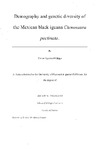Demography and genetic diversity of the Mexican black iguana Ctenosaura pectinata
| dc.contributor.author | Aguirre-Hlidalgo, Victor | |
| dc.contributor.other | School of Biological and Marine Sciences | en_US |
| dc.date.accessioned | 2013-11-21T14:32:24Z | |
| dc.date.available | 2013-11-21T14:32:24Z | |
| dc.date.issued | 2008 | |
| dc.identifier | NOT AVAILABLE | en_US |
| dc.identifier.uri | http://hdl.handle.net/10026.1/2810 | |
| dc.description.abstract |
The hunting of the black iguana (Ctenosaura pectinata) in some regions of Mexico constitutes an acute problem because mature, gravid females arc killed and eaten just before they lay their eggs. This practice thus impacts both the survival of adults and the otherwise imminent recruitment of new individuals to the population. The objective of this project was to compare the demographic behaviour and the genetic variability of two population of the black iguana, one protected and one subject to hunting. This information allowed us to project their population dynamics and investigate the likely population-level consequences of hunting. A clear difference in age structure was observed between the two populations, with younger reproductive individuals and shorter lifespan in the hunted population. Body size was also different and reproductive individuals tended to be bigger and produce bigger clutch sizes in the hunted population than in the protected one. Survival rate of hatchlings and yearlings was estimated in both populations using soap moulds. A clear difference in survival was observed. This difference is related to the absence of natural predators in the more disturbed (hunted) area. Genetic diversity was estimated using mitochondrial DNA and differences in haplotype and nucleotide diversity between the two populations were found. It was therefore concluded that the hunted population (Nizanda) is at higher risk of suffering genetic bottlenecks. Age-based matrix projections and population viability analysis revealed that under the present conditions both populations can persist. They, however, show that current hunting levels in a closed population would cause local extinction in the short term. The study makes it possible to infer that although black iguanas are resilient to a substantial amount or disturbance and modification or their population parameters, the gradual loss of numbers and genetic variability will increase their risk of extinction in the near future. Management actions to diminish this risk are suggested. | en_US |
| dc.language.iso | en | en_US |
| dc.publisher | University of Plymouth | en_US |
| dc.title | Demography and genetic diversity of the Mexican black iguana Ctenosaura pectinata | en_US |
| dc.type | Thesis | |
| plymouth.version | Full version | en_US |
| dc.identifier.doi | http://dx.doi.org/10.24382/3597 |
Files in this item
This item appears in the following Collection(s)
-
01 Research Theses Main Collection
Research Theses Main


